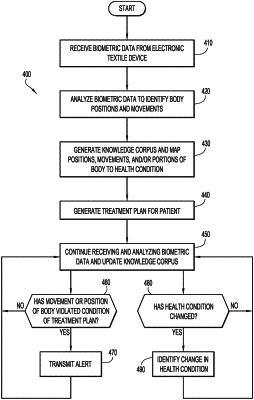| CPC G16H 20/30 (2018.01) [A61B 5/1114 (2013.01); A61B 5/1124 (2013.01); A61B 5/4824 (2013.01); A61B 5/6804 (2013.01); A61B 5/746 (2013.01); G16H 40/67 (2018.01); G16H 50/30 (2018.01); G16H 50/70 (2018.01); G16H 50/20 (2018.01)] | 17 Claims |

|
1. A computer-implemented method for patient monitoring and treatment using electronic textiles, the method comprising:
receiving biometric data pertaining to a user, wherein the biometric data is obtained over time from an electronic textile device associated with a body of the user, wherein the electronic textile device includes a plurality of elements corresponding to one or more particular locations of the body of the user, the plurality of elements including pressure sensing elements, and one or more heating elements;
analyzing the biometric data to identify positions and movements of the body of the user;
analyzing the identified positions and movements of the body to generate a knowledge corpus for the user that maps one or more of: positions, movements, and portions of the body to a health condition of the user, wherein the identified positions include a side of the body of the user that is in contact with a bed, and wherein the analysis classifies a particular identified position of the body of the user as being unrelated to the health condition of the user if the user occupies the particular identified position for at least a predetermined amount of time;
generating a treatment plan for the user based on the knowledge corpus, wherein the treatment plan indicates a relatedness between the health condition of the user and the one or more positions, movements, and portions of the body;
presenting, to a health care practitioner, a visualization of the relatedness between the health condition of the user and the one or more positions, movements, and portions of the body, wherein the visualization comprises augmented reality data that is presented to a health care provider via an augmented reality display device, and wherein the visualization presents a heat map of portions of the body that are associated with positions and movements that are specific to a particular disease of the patient while omitting from the heatmap other movements or positions of the body that are not specific to the particular disease; and
activating the one or more heating elements at an area of the body of the patient that corresponds to the side of the body of the patient that is determined based on the treatment plan by analyzing the identified positions and movements of the body, wherein the one or more heating elements of the electronic textile device are activated by transmitting instructions to the electronic textile device.
|